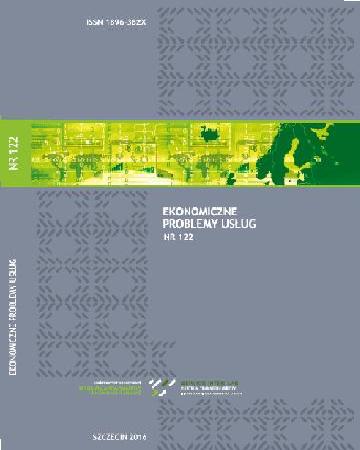
ISSN: 1896-382X
eISSN: 2353-2866
OAI
DOI: 10.18276/epu.2018.132-07



Issue archive /
nr 132 2018
Instrumenty pochodne w zarządzaniu ryzykiem przedsiębiorstw
(THE DERIVATE PRODUCTS IN ETERPRISE RISK MANAGEMENT)
| Authors: |
Mirosława
Mioducka
Politechnika Poznańska Wydział Inżynierii Zarządzania, Katedra Przedsiębiorczości i Komunikacji w Biznesie Joanna Małecka Politechnika Poznańska Wydział Inżynierii Zarządzania, Katedra Przedsiębiorczości i Komunikacji w Biznesie |
| Keywords: | small and medium enterprises internationalization currency risk risk management derivatives |
| Data publikacji całości: | 2018-09-27 |
| Page range: | 11 (83-93) |
| Klasyfikacja JEL: | D81 F13 F18 F23 L22 |
Abstract
Poland’s accession to the European Union has increased the chances of small and medium-sized enterprises to change their business strategy and open up to international markets. The development of entrepreneurship has forced business owners to develop a risk management concept for the purposes of foreign trade. The article attempts to answer questions about the banking products used by the Polish SME sector in order to minimise currency risk, and which of the forms of business most often buy such financial instruments. The research results are based on data from reports and publications made available by financial market institutions and on own research based on empirical data provided by one of the Polish
commercial banks.
Download file
Article file
Bibliography
| 1. | Al-Own, B., Minhat, M., Gao, Simon, S. (2018). Stock options and credit default swaps in risk management. Journal of International Financial Markets Institutions & Money, 53, 200–2014. DOI: 10.1016/j.intfin.2017.09.021. |
| 2. | Bhagawan, P., Lukose, J. (2018). The determinants of currency derivatives usage among Indian non-financial firms An empirical study. Studies in Economics and Finance, 34 (3), 263–382.DOI: 10.1108/SEF-09-2014-0172. |
| 3. | Czernik, A., Stefański, M. (2016). Małe i średnie firmy w Polsce – bariery i rozwój. Warszawa: Polityka Insight. Pobrano z: https://static3.bzwbk.pl/asset/m/a/l/male-i-srednie-firmy--w-polsce2_-polityka-insight_61682.pdf?_ga=2.121283851.2027830316.1500979429-873373943.1489735486. |
| 4. | Diaz, M., Vaquero, J.D. (2017). Foreign currency risk management practices in Spanish companies:An empirical analysis. Aestimatio – the IEB International Journal of Finance, 14, 128–163. |
| 5. | Gulanowski, D., Papadopoulos, N., Plante, L. (2018). The role of knowledge in international expansion: Toward an integration of competing models of internationalization. Review of International Business and Startegy, 28 (1), 35–60. DOI: 10.1108/RIBS-09-2017-0077. |
| 6. | Hentschel, L., Kothari, S.P. (2001). Are corporations reducing or taking risk with derivatives? Journal of Financial and Quantitative Analysis, 36 (1), 93–118. DOI:10.2307/2676199. |
| 7. | Hsiao, Y., Tsai, W. (2018). Financial literacy and participation in the derivatives markets. Journal of Banking & Finance, 88, 15–29. DOI: 10.1016/j.jbankfin.2017.11.006. |
| 8. | Jermann, U.J., Yue, V.Z. (2018). Interest rate swaps and corporate default. Journal of Economics Dynamics & Control, 88, 104–120. DOI: 10.1016/j.jedc.2018.01.022. |
| 9. | Jorge, M.J., Augusto, M.G. (2016). Is hedging successful at reducing financial risk exposure? Applied Econimics, 48 (39), 3695–3713. DOI:10.1080/00036846.2016.1142663. |
| 10. | Kasperkowiak, W., Małecka, J., Łuczka, T. (2017). Risk in the internationalisation of small and medium-sized enterprises – selected aspects. Proceedings of the 5th International Conference Innovation Management, Entrepreneurship and Sustainability. Praga: Oeconomica. |
| 11. | Kim, S.F., Chance, D.M. (2018). An empirical analysis of corporate currency risk management policies and practices. Pacific-Basin Finance Journal, 47, 109–128. DOI: 10.1016/j.pacfin.2017.12.004. |
| 12. | Laborda, R. (2018). Optimal combination of currency strategies. North American Journal of Economics and Finance, 43, 129–140. DOI: 10.1016/j.najef.2017.10.010. |
| 13. | Łuczka, T., Przepióra, P. (2010). Finanse międzynarodowe. Poznań: Wydawnictwo Politechniki Poznańskiej. |
| 14. | Łuczka, T., Małecka, J. (2017). Prospects for increasing international trade volumes of selected micro and small enterprises in Poland. Decision making for Small and Medium-Sized Enterprises Conference proceedings DENSME 2017, Pobrano z: http://demsme.cms.opf.slu.cz/ images/demsme2017proceedings.pdf. |
| 15. | Małecka, J.(2017). The role of SMEs in international trade: Selected aspects, Institute of Economic Research Working Papers, No. 68/2017. Pobrano z: http://econpapers.repec.org/scripts/redir.pf?u=http%3A%2F%2Fwww.badania-gospodarcze.pl%2Fimages%2FWorking_Papers%2F2017_No_68.pdf;h=repec:pes:wpaper:2017:no68. |
| 16. | Małecka, J., Łuczka T., Šebestová, J., Šperka, R. (2017). Economic Activity, Social Conditions and Entrepreneurship in Poland – Selected Aspects. Copernican Journal of Finance & Accounting, 3 (6), 47–61. DOI: 10.12775/CJFA.2017.016. |
| 17. | Miciuła, I. (2012). Współczesne metody i instrumenty zarządzania ryzykiem walutowym w przedsiębiorstwie. Zeszyty Naukowe Uniwersytetu Szczecińskiego, 734. Studia i Prace WNEiZ US, 28, 67–80. |
| 18. | NBP (2016a). Wyniki badania obrotów w kwietniu 2016 r. na rynku walutowym i rynku pozagiełdowych instrumentów pochodnych w Polsce. Pobrano z: https://www.nbp.pl/systemfinansowy/polska2016.pdf. |
| 19. | NBP (2016b). Szybki Monitoring NBP. Warszawa: Instytut Ekonomiczny. Pobrano z: http://www.nbp.pl/publikacje/koniunktura/raport_4_kw_2016.pdf . |
| 20. | Orzeł, J. (2012). Zarządzanie ryzykiem operacyjnym za pomocą instrumentów pochodnych. Warszawa: Wydawnictwo Naukowe PWN. |
| 21. | [PARP] (2017). Raport o stanie sektora małych i średnich przedsiębiorstw w Polsce 2017. Pobrano z: https://www.parp.gov.pl/images/PARP_publications/pdf/raport%20o%20stanie%20sektora%20msp%20w%20polsce_2017.pdf . |
| 22. | Shane, S. (2003). A General Theory of Entrepreneurship. the Individual – Opportunity Nexus. Northampton: Edward Elgar Pub. |
| 23. | Tse, CH., Yu, L.H., Zhu, J.J. (2017). A Multimediation Model of Learning by Exporting: Analysis of Export-Induced Productivity Gains. Journal of Management, 43 (7), 2118–2145. DOI:10.1177/0149206315573998. |
| 24. | Tymoczko, I. (2009). Sposoby zabezpieczania się polskich przedsiębiorstw niefinansowych przed ryzykiem kursowym. Bank i Kredyt, 40 (3), 71–92. |
| 25. | Ustawa z 29 lipca 2005 r. o obrocie instrumentami finansowymi. Dz. U. nr 183, poz. 1358 |